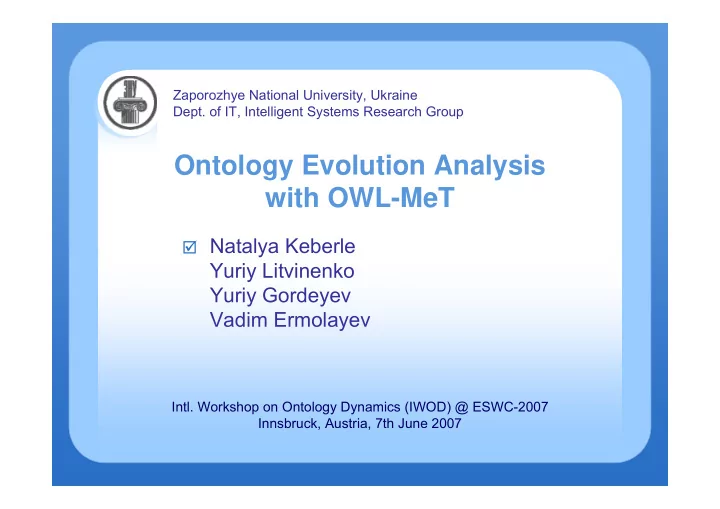

Zaporozhye National University, Ukraine Dept. of IT, Intelligent Systems Research Group Ontology Evolution Analysis with OWL-MeT Natalya Keberle � Yuriy Litvinenko Yuriy Gordeyev Vadim Ermolayev Intl. Workshop on Ontology Dynamics (IWOD) @ ESWC-2007 Innsbruck, Austria, 7th June 2007
Ontology Evolution Analysis(1) Versions compatibility = ≠ Domain Domain Domain time XIXth XXth XXIth = ≠ - “Can I rely on the fact that a Student in the XXI century is the same a Student as in the XIXth?” 2
Ontology Evolution Analysis(2) Checking derivability of a fact in different versions an Entrant Graduated time a Student - “Is it true that if Mike is a Student now, he was an Entrant some time Mike ago and he will be a Graduate in some time in the future?” 3
Ontology Evolution Analysis(3) Structural analysis of versions and of version changes a Student - “Get the properties of a Student of the XIX century” XIXth XXIth time - “What was changed in ≠ the definition of a Student of the XXI century as compared to the one of the XIX century?” a Student 4
Ontology Evolution Analysis "wishlist” • Ontology Version Management System – All ontology versions are available – Or, there is a version log – Or, both versions and a version are available • Explicit referencing of ontology versions • Different Query Types – Reasoning queries – Meta - level queries on versions compatibility – Retrieval queries 5
Existing approaches to ontology evolution analysis • Versioning and structural analysis of version logs OntoView [Klein 2004] • Proof-theoretic approach – usage of temporal logic MORE tool [Huang & Stuckenschmidt, 2005] – LTLm 6
Requirements for Temporal Logic • The notion of distance - Metric logic • Explicit version names addressing - Hybrid logic • Semantic Web oriented - Description logic 7
Temporal Logics overview • Propositional: – LTL, CTL – MT MT [Hustadt et al. 2005] – PTC(MT) [Keberle 2005] Reasoning support : LoTREC (refl.& trans. frames), MetTel, … • DL-oriented: – Schild’s logic [Schild 1993] – Family of CIQ CIQ US US [Wolter & Zakharyashev 1999] – TL TL - ALCF ALCF [Artale & Franconi 2000] Reasoning support : open question 8
ALCIO ( MT ALCIO MT ) proposal 9
ALCIO ALCIO ( MT MT ) Specific semantics of ALCIO MT ) is defined on reflexive ALCIO ( MT and transitive frames 10
ALCIO ALCIO ( MT MT ) ALCIO ( MT MT ) is decidable as the syntactic variant of CIQ ALCIO CIQ US US SAT problem for ALCIO MT ) is EXPTIME-hard [Areces, ALCIO ( MT Blackburn & Marx 1999] Tableau-based procedure of SAT checking is developed 11
OWL-MeT proposal • OWL-MeT : O ntology W eb L anguage for Me tric T ime • Metric and Temporal extension of OWL • Based on ALCIO ( MT ) PLUS • Definition of TimeStructure for versions identification and ordering. TimeStructure is a finite set of version IDs . TInstant TInstant TInstant TInstant past… …future 1 2 3 4 12
OWL-MeT examples Student is… 3rd year student is… <TClass rdf:ID=“Entrant"/> <TClass ID=“Entrant"/> <TClass rdf:ID=“Graduated"/> <TClass rdf:ID="Student"> <TClass rdf:ID=“Student"> <rdfs:subClassOf> <equivalentClass> <TRestriction> <intersectionOf> <past rdf:datatype= <TRestriction> "&xsd;#NonNegativeInteger"> <somepast rdf:resource="#Entrant“/> 3 </past> </TRestriction> <equivalentClass> <TRestriction> <TClass rdf:about="#Entrant"/> <allfuture> </equivalentClass> <TClass> </TRestriction> <unionOf> </rdfs:subClassOf> <TClass about="#Student"/> </TClass> <TClass about="#Graduated"/> </unionOf> </TClass> </allfuture> </TRestriction> </intersectionOf> </equivalentClass> 13 </TClass>
Sources of Reasoning Support for OWL-Met Engine OWL Support Status incomplete OWL DL Freeware KAON2 OWL DL Opensource FaCT++ OWL DL Commercial RacerPro OWL DL Opensource Pellet incomplete OWL DL Opensource Jena 14
Changes in Pellet ABox SPARQL Parser ( RDF/XML, Turtle etc) query engine parser Species validation and ontology repair i Jena n application TBox ABox t e T u KnowledgeBase OWL API TBox absorption r Tableau interface f application Reasoner a T g c DIG XSD e application internalization s reasoner 15
Changes in Jena • added file owlmet.owl to Jena • owlmet: TClass is subClassOf rdf:Class • owlmet: TRestriction is subClassOf TClas s • owl: Class is subClassOf owlmet:TClass • owlmet:Instant is subClassOf owlmet:TClass • Redifined properties like “ equivalentClass ”, “ disjointWith ” to operate on TClasses • Added properties for “ allfuture” /” somefuture” /” future n” • Added properties for “ at” (rdfs required also to add property “ happens ”) 16
Back to Evolution Analysis • Reasoning queries e.g. ( C intersection (( past 2 ) not C )) @{ v5 } meaning: “What are the new individuals of concept C in a version v5 , which were not present two versions before?” 17
Back to Evolution Analysis • Meta-level queries Given version i, ontology Oi, concept Gi –intersection of the definitions of all concepts and individuals in Oi. Then |— Gi @ {i} – checking SAT for Oi |— Gi @ {j} – checking SAT for Oi in j |— GE,i @ {i} – checking SAT for concept E (from i) in version i |— GE,i @ {j} – checking SAT for concept E (from i) in version j |— (Gi intersection Gj) @ {j} GE,i - compiled [Stuckenschmidt & Klein 2003] concept from all explicit and implicit definitions of E in version i 18
Back to Evolution Analysis • Retrieval queries e.g. Child (C,B)@{j} intersection (not Child(C,B)@{i}) meaning “Get new children B of concept C appeared in the version j as compare to the version i” Might require new roles/role restrictions to be introduced 19
Future Work • Real cases (propositions are welcome) • Optimization • Combination of TimeStructure concept with an ontology of temporal aggregates (years, monthes, days,….) – e.g. with OWL-Time [J.Hobbs&F.Pan 2004] • Fusion (decidability in mind) between pure DL and temporal parts – like roles/role restrictions over TClasses 20
21 http://ermolayev.com/owl-met/ Additional info
Shall be happy to answer your questions
Recommend
More recommend